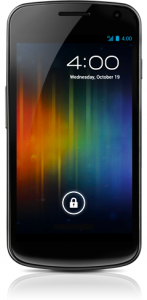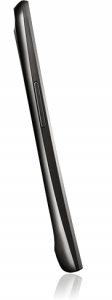The Galaxy Nexus: Android’s Answer to the iPhone 4S
 At a joint event in Hong Kong hosted by Samsung and Google, the Galaxy Nexus was just announced. On the heels of the iPhone 4S announcement, the Galaxy Nexus has some big shoes to fill, but just like the 4S announcement, the Galaxy Nexus was met with mixed reviews.
At a joint event in Hong Kong hosted by Samsung and Google, the Galaxy Nexus was just announced. On the heels of the iPhone 4S announcement, the Galaxy Nexus has some big shoes to fill, but just like the 4S announcement, the Galaxy Nexus was met with mixed reviews.
Nexus Gets Some New Hardware
Expectations were extremely high for the Galaxy Nexus, as die-hard Android fans know that the Nexus name is supposed to be a flagship device for the Android platform. Prior to the announcement, rumored specs for the Galaxy Nexus were all over the place, some suggesting a quad-core processor and others claiming things like a 14MP camera.
 So when it was revealed that the Galaxy Nexus would only have a 1.2GHz dual-core processor, there was a bit of disappointment. To put this into perspective, though, the iPhone 4S’s dual-core processor runs at a reported 800MHz, so at 1.2GHz, the Galaxy Nexus will still perform quite well; however, other 1.2GHz dual-core devices have been out for a while, like the Galaxy S II.
So when it was revealed that the Galaxy Nexus would only have a 1.2GHz dual-core processor, there was a bit of disappointment. To put this into perspective, though, the iPhone 4S’s dual-core processor runs at a reported 800MHz, so at 1.2GHz, the Galaxy Nexus will still perform quite well; however, other 1.2GHz dual-core devices have been out for a while, like the Galaxy S II.
The 5MP camera also came as a disappointment to some, though don’t let the low megapixel count fool you. The Galaxy Nexus’ camera has seen some major upgrades compared to other models. It features zero shutter lag and can take photos in rapid succession. It can also record stunning videos 1080p while simultaneously allowing you to take full resolution photos. So even though many smartphones feature an 8MP camera, like the Sony Ericsson Xperia Arc and HTC Sensation, the Galaxy Nexus can still take equally impressive photos; however, it won’t be taking any 3D shots like the EVO 3D can.
 Compared to its predecessor (the Nexus S), the Galaxy Nexus brought some significant improvements to the display, something the iPhone 4S failed to do. This new Nexus features a stunning HD 1280 by 720 Super AMOLED display. This combines the high-density of the iPhone’s Retina Display with the vivid color and power saving features of AMOLED. At 4.65 inches, the display makes for a fairly large device, but because it does away with all of the buttons on its face, it’s about the same size as most 4.3-inch display phones. Despite its size, its curved glass display helps it fit nicely in your hand, in your pocket, or against your face when making a call.
Compared to its predecessor (the Nexus S), the Galaxy Nexus brought some significant improvements to the display, something the iPhone 4S failed to do. This new Nexus features a stunning HD 1280 by 720 Super AMOLED display. This combines the high-density of the iPhone’s Retina Display with the vivid color and power saving features of AMOLED. At 4.65 inches, the display makes for a fairly large device, but because it does away with all of the buttons on its face, it’s about the same size as most 4.3-inch display phones. Despite its size, its curved glass display helps it fit nicely in your hand, in your pocket, or against your face when making a call.
Lastly, the Galaxy Nexus features 4G connectivity, a small blow to the iPhone 4S. Depending on region, it will come in either 4G LTE or 4G HSPA+ varieties.
Android Version 4.0 Ice Cream Sandwich
 Even though the Galaxy Nexus’ hardware didn’t blow everything else out of the water, it was only half of the equation. Perhaps the biggest benefits it brings are with the new version of Android, 4.0 Ice Cream Sandwich.
Even though the Galaxy Nexus’ hardware didn’t blow everything else out of the water, it was only half of the equation. Perhaps the biggest benefits it brings are with the new version of Android, 4.0 Ice Cream Sandwich.
With Ice Cream Sandwich, Google gave Android a major overhaul, adding countless new features, the majority of which were designed to make Android more effective and easier to use. The camera features mentioned above were only the tip of the ice berg. Android 4.0 brings an entirely new user interface which is now even more customizable than ever, but in a much more intuitive way. It also includes new task management features for increased control over the apps running on your phone, enhanced data use reporting which is especially useful for anyone on a tiered data plan, and perhaps most importantly, hardware acceleration.
Hardware acceleration was a key element missing from previous versions of Android. It allows for the most advanced graphics hardware to run the entire interface, giving you a silky smooth experience more akin to iOS.
 Like iOS 5, Andriod 4.0 brings some familiar enhancements, like integrated social networking and native photo editing. Android 4.0 even gave its voice recognition software an upgrade, and though it greatly improves the voice-to-text experience, it’s still no match for the capabilities of Siri.
Like iOS 5, Andriod 4.0 brings some familiar enhancements, like integrated social networking and native photo editing. Android 4.0 even gave its voice recognition software an upgrade, and though it greatly improves the voice-to-text experience, it’s still no match for the capabilities of Siri.
Do you think the Galaxy Nexus has what it takes to earn the top spot in our smartphone ranks? Let us know in the comments.


